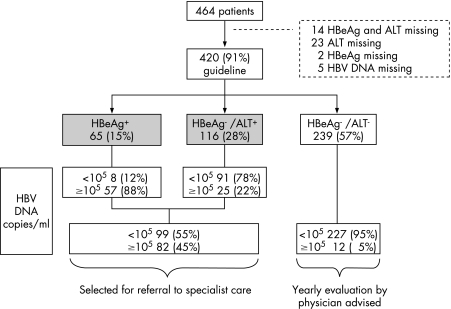Practice guidelines have been developed to select patients with chronic hepatitis B who might benefit from antiviral treatment.1,2,3 These sophisticated guidelines are directed at specialist care, and include the assessment of serum hepatitis B virus (HBV) DNA. However, most patients with chronic HBV are diagnosed in primary care where HBV DNA is usually not assessed. A simpler, less expensive guideline that can be used at the primary care level to select patients for referral to specialist care can reduce the number of patients referred who, after evaluation by a specialist, are ineligible for treatment. By preventing the referral of ineligible patients, the disappointment that patients with high expectations experience after referral to a specialist is avoided. Furthermore, it reduces the burden on the healthcare system.
A guideline for the referral of patients with chronic HBV in primary care, based on hepatitis B e‐antigen (HBeAg) status and alanine aminotransferase (ALT) level, has been in use in Rotterdam since 2002.4 We assessed the accuracy of this simple guideline to predict high HBV DNA levels, defined as >105 copies/ml as this cut‐off point is recommended in clinical practice.1,2
The study population was an unselected population‐based cohort of 464 newly diagnosed patients with chronic HBV in Rotterdam, The Netherlands. Half of the study population was female. The patients were aged 8–80 years and were from various ethnic backgrounds. Patients were considered eligible for referral if they were positive for HBeAg or had increased ALT levels. Patients not selected for referral were referred to their general practitioner for annual monitoring of their ALT level. The HBV DNA viral load was determined as described previously.5 Positive predictive value, negative predictive value, sensitivity and specificity of the referral guideline and its components, HBeAg and ALT, were calculated with 95% CIs. The procedure is illustrated in a flow chart (fig 1), and table 1 summarises the results.
Figure 1 Flow chart of patients by hepatitis B e‐antigen (HBeAg) status, alanine aminotransferase (ALT) level and serum hepatitis B virus (HBV) DNA level.
Table 1 Characteristics of different determinants for selection for referral.
| Determinant for selection for referral (% and 95% CI) | |||
|---|---|---|---|
| HBeAg+ or ALT+ | HBeAg+ | ALT+ in HBeAg− | |
| Prevalence of determinant | 43 (38 to 48) | 15 (12 to 19) | 33 (28 to 38) |
| Positive predictive value* | 45 (38 to 53) | 88 (78 to 94) | 22 (15 to 30) |
| Negative predictive value† | 95 (91 to 97) | 90 (86 to 92) | 95 (91 to 97) |
| Sensitivity‡ | 87 (80 to 93) | 61 (51 to 70) | 68 (51 to 80) |
| Specificity§ | 70 (64 to 74) | 98 (95 to 99) | 71 (66 to 76) |
ALT, alanine aminotransferase; HBeAg, hepatitis B e‐antigen; −, negative; +, positive.
*Proportion of patients selected for referral who had high viral loads.
†Proportion of patients not selected for referral who had low viral loads.
‡Proportion of patients with high viral loads who were selected for referral.
§Proportion of patients with low viral loads who were not selected for referral.
According to the referral guideline, 43% (181/420) of the patients were eligible for referral to specialist care. The positive predictive value of the referral guideline was 45%, as 82 of 181 patients selected for referral had high viral loads. The negative predictive value was 95%, as 227 of 239 patients not selected for referral had low viral loads. The patients selected for referral included 82 of 94 patients with high serum HBV DNA, which corresponded to a sensitivity of 87%. When only patients with a positive HBeAg test were referred, the number eligible for referral could be reduced to the 15% of patients who were HBeAg positive. However, although the predictive value of a positive HBeAg test was high at 88%, the sensitivity was unacceptably low, and almost 40% of patients with a high viral load would have been missed. The sensitivity of an increased ALT level in patients who were HBeAg negative was also low at 68%, but the combination of both test results in the guideline improved the sensitivity to an acceptable 87%.
Of 12 patients with high viral loads who were not selected for referral by the guideline, 11 had a viral load of 105–106 copies/ml. We checked whether these patients had, in one way or another, been seen by a specialist at the Department of Gastroenterology and Hepatology of Erasmus Medical Center, Rotterdam, The Netherlands, which was the case for three of them. All three were referred back to their general practitioner after exclusion of significant liver disease. Another patient had an extremely high viral load of 2×1010 copies/ml. He was a 65‐year‐old Dutch man who was tested because of dialysis, and was already under the care of a specialist.
We conclude that a guideline based on HBeAg and a single ALT determination can successfully predict viral load in patients with chronic HBV and can be used in primary care to select patients for referral to specialist care.
Acknowledgements
We thank the public health nurses of the MPHS for their cooperation.
Footnotes
Competing interests: None.
References
- 1.Lok A S, McMahon B J. Chronic hepatitis B. Hepatology 200745507–539. [DOI] [PubMed] [Google Scholar]
- 2.de Franchis R, Hadengue A, Lau G.et al EASL International Consensus Conference on Hepatitis B. 13‐14 September, 2002 Geneva, Switzerland. Consensus statement (long version). J Hepatol 200339(Suppl 1)S3–25. [PubMed] [Google Scholar]
- 3.Liaw Y F, Leung N, Guan R.et al Asian‐Pacific consensus statement on the management of chronic hepatitis B: a 2005 update. Liver Int 200525472–489. [DOI] [PubMed] [Google Scholar]
- 4.Mostert M C, Richardus J H, de Man R A. Referral of chronic hepatitis B patients from primary to specialist care: making a simple guideline work. J Hepatol 2004411026–1030. [DOI] [PubMed] [Google Scholar]
- 5.Pas S D, Niesters H G. Detection of HBV DNA using real time analysis. J Clin Virol 20022593–94. [DOI] [PubMed] [Google Scholar]



